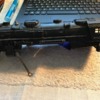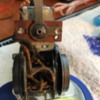I was able to pick up a Lionel 2026 2-6-4 steam engine at a local yard sale for $15 to start my first restoration project. I believe it is the 1953 Adriatic version with pick-up rollers underneath.
The gear/drive train moves freely and there are no obvious broken, frayed or disconnected wires (at least to my untrained eye). I took off the brush plate and cleaned the motor. It hums when I apply power but does not move and I am thinking it is the e-unit, specifically ,the drum roller appears to be cocked inside and not moving freely.
Are there any tricks to freeing up the e-unit w/o getting too far into a complete teardown ?
Thanks












